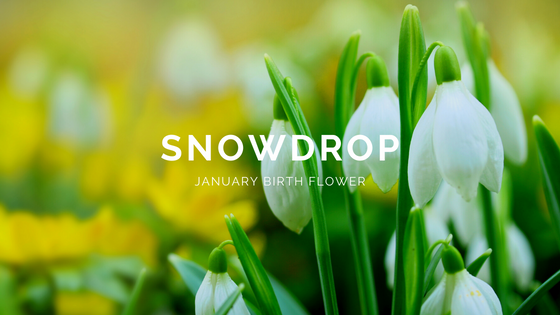The January Birth Flower is not only one flower but two. The January Birth Flowers are: Carnation and Snowdrop. If you were lucky enough to be born in January the carnation and the snowdrop represent who you are.
What Are Birth Flowers?
Birthstones are well-known, but birth flowers are less well-known. According to legend, birth flowers originated in the Roman Empire. People would bring lavish gifts to birthday celebrations, such as jewelry containing that month’s birthstone and flowers that grew in the person’s birth month.
January Birth Flower Carnation
The Carnation represents distinction, love, and fascination. A person born in this month is said to have these characteristics. Throughout the ages people have presented others with carnations.

Carnation Color Meanings
Each color of carnation is said to have its own distinct meaning.
If a person presents you with a red carnation, they are telling you that they love you and that there heart can not live without you.
Yellow speaks of disappointed or a jilted lover.
White tells the story of pure love.
A pink carnation let’s a person know that they will always be with you and never be forgotten. It can also stand for motherly love.
Pink Carnations Myth
The pink carnation has the most historical significance of any carnation. One of the most well-known legends concerns Jesus on the cross. According to legend, Mother Mary stood by the side of the road and watched as Jesus was dragged down the road on the cross. When she saw him, she burst into tears. When her tears fell to the ground, they turned into pink carnations, symbolizing her motherly love for him and the fact that he would never be forgotten.
January Birth Flower History
The Month of January Birth Flower, the carnation, dates back over 2,000 years. It is believed that they were first cultivated in the east. A great attribute of the carnation is its ability to be died any color imaginable. Unlike many other flowers the carnation has a very lovely scent. Over the years there have been many different names that represented the carnation including Sweet William, Maiden Pink, Pinks, and Dianthus. The word carnation comes from the Greeks and means, “flower of the gods”.
How To Grow Carnations?
The January Birth Flower carnation can be easily grown, which also makes it a very popular flower. The Spanish use it for many of their religious ceremonies and holidays, while the French grow carnations to harvest oil from them. It is also said to have special powers and is sometimes used for healing and for protection. This flower can grow anywhere from 1 ft to 3ft.
January Birth Flower Snowdrop
Why the snowdrop is also considered a January Birth Month Flower is unknown. The snowdrop is also known as a galanthus. Many people believe that it is a birth flower because it blooms at the end of winter or in January and is sometimes the color of snow. They are also among the very first flowers to bloom in the spring. Galanthus is a Greek word that means “Milkflower.” Snowdrops are called nivalis in Latin, which means “like snow.”

History Behind Snowdrop Flower
The snowdrop is native to Europe, but it has been cultivated in a variety of other locations. This flower is commonly thought to be a British wildflower; it was most likely brought to Britain by the Romans in the 1600s.
Snowdrop Types
Galanthus is a perennial plant that grows from bulbs. Snowdrops come in a variety of varieties, the most common of which is the glanthus. Crimeans, giant snowdrops, and galanthus regineae-olgae snowdrops are some other types of snowdrops.
How To Grow Snowdroops?
Snowdrops are often found growing in clusters on forest floors or along stream beds. Large groups of these plants can be seen when they start to bloom in early spring. The flowers can also be grown indoors as houseplants during the winter months. The Latin name for the snowdrop is Galanthus nivalis, and it is a member of the Amaryllidaceae family. The plant has many different common names, including the European snowdrop and winter aconite. It grows best in full sun or partial shade and can survive temperatures as low as -30 degrees Celsius (-22 Fahrenheit).
Conclusion
If you have been asking yourself the question, What is the January Birth Flower? Your answer is the carnation and the snowdrop. The carnation is said to stand for distinction, love, and fascination, were as the snowdrop represents snow and the welcoming of spring. The January birth flowers both offer a feeling of romance and hope.
